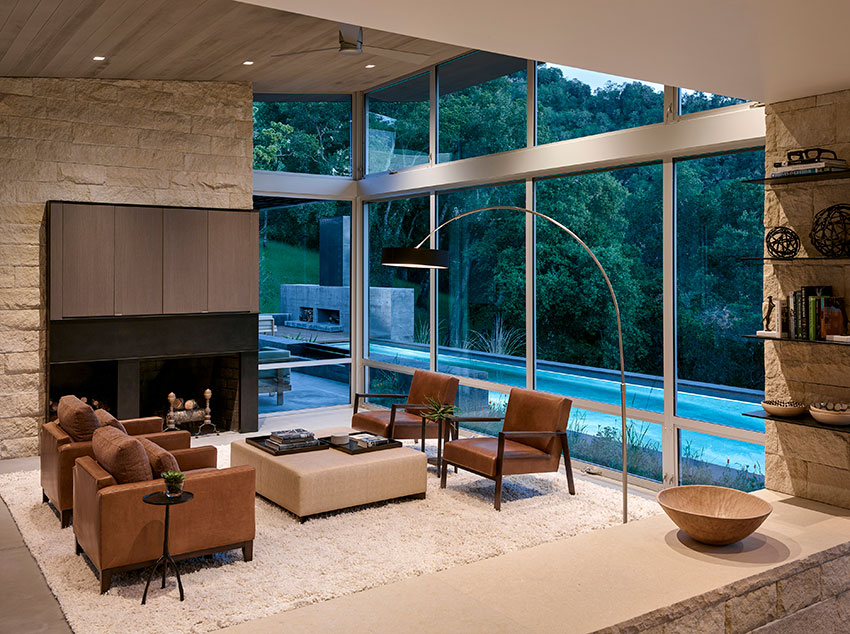Specifying Aluminum High-Performance Windows and Doors
Further Considerations
Durability, daylighting, and acoustic performance are among other aspects enabled by high-performance aluminum windows and doors. To select for certain IEQ properties, it’s important to understand how these aluminum profiles work and how they are best optimized for each system.
Structural Strength
The strength of aluminum enables glass-clad structures to meet wind load provisions of Minimum Design Loads for Buildings and Other Structures, Standard ASCE/SEI 7-10. (ASCE is the American Society of Civil Engineers.)
Daylighting
The slimmer profiles of extruded aluminum window and door frames increase the amount of daylight entering the window, sometimes by as much as 20%.
Acoustic Performance
External acoustic performance is measured by the outdoor–indoor transmission class (OITC), which measures the sound transmission through exterior walls from outside sound sources. This performance is affected by the design of the window and door frame, thermal breaks, gaskets, and seals, etc., inherent in all aluminum frames. Reduced sound levels reduce stress in healthcare facilities and improve productivity in workplaces.
Maintenance Requirements and Durability
Aluminum not only is extremely durable but also requires minimum maintenance after installation. In general, periodic washing with soap and water is all that is required. Manufacturers can supply further information if necessary.
Receptor Frames
Receptor frames are additional framing components that encase or surround one or more window components in a similar manner to that of stud tracks, which hold light-gauge metal studs in place. They are generally used to simplify window installation and save time and money. They will be discussed in more detail in the next section of the course.

Photo courtesy of Tour Space
Designed by Feldman Architecture, the Spring Ranch residential project features floor-to-ceiling, multilite combination configuration aluminum windows for aesthetic value.
Window And Door Performance And Standards
This section explores desired performance targets, the standards that inform them, and the technologies that can be used to address and meet them.
Performance Requirements
The specification excerpt below provides a sample condensed shopping list of performance levels that should be determined during the design process.
- A. Design pressure, air infiltration, and water penetration
1. Comply with AAMA/WDMA/CSA 101/I.S.2/A440 [AW-PG80]
- B. Uniform Load Deflection and Uniform Load Structural to ASTM E330
- C. ASTM E283, Air Leakage: 6.27 psf: 0.1 cfm/ft2 maximum
- D. ASTM E547, Water Penetration: at 12.11 psf: No leakage
- E. ASTM F588, Forced Entry Resistance: Type B Grade
Type B Grade 10: Pass for No entry
- F. U-Factor [____]
- G. Solar Heat Gain Coefficient (SHGC) [____]
- H. Acoustical Performance: STC [____]
Energy codes continuously reduce the amount of energy that residential and commercial buildings can use. Window and door design must follow this trend to become more and more energy efficient. The primary driving or model codes are ASHRAE 90.1 and the IECC (International Energy Conservation Code). These codes must be adopted locally to have force.
Other relevant codes and standards include IgCC (International Green Construction Code), ASHRAE 189.1, ENERGY STAR, and DOE Zero Energy Ready Homes. The goal of DOE Zero Energy Ready Homes is that 100% of all new commercial (including high-rise residential) buildings will produce as much energy as they use by 2025. Window and door performance will be a major factor in enabling this goal, and glazing techniques may include the incorporation of photovoltaics in the building cladding system.

Photo courtesy of All Weather Architectural Aluminum
The Brewster Estate features an open concept floor plan with large, high-performance sliding glass doors and windows to maximize the indoor/outdoor living spaces.
U-factor, solar heat gain coefficient (SHGC), air leakage, and, possibly, visible light transmittance are critical for compliance with any code. These properties must be provided as certified ratings determined by independent laboratories in accordance with National Fenestration Rating Council (NFRC) standards. Air leakage ratings can be based on the North American Fenestration Standard (NAFS). The component modeling approach (CMA) can generate ratings for commercial fenestration. The CMA program of the NFRC is an online database of energy performance information for window, door, and skylight components, which provides the following:
- Help to nonresidential manufacturers to see how changing one component can affect overall energy efficiency
- Information on which components can be combined
- Determination of whole-product energy performance ratings for fenestration systems









